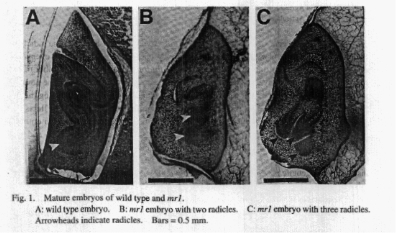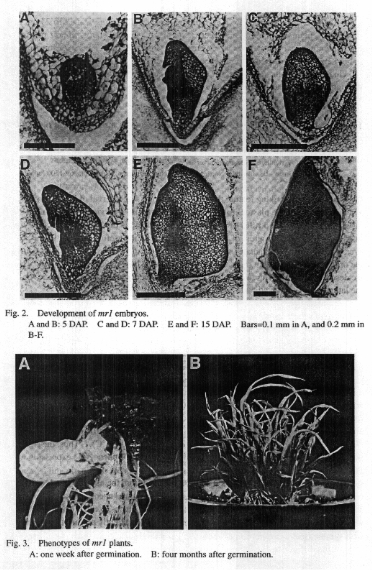|
9. A multiple radiciel mutation affects the number of radicles
and the vegetative
growth in rice
During embryogenesis in rice, one embryo differentiates one
shoot and one radicle in the predictable positions, establishing the basic
body plan of the plant. These events are controlled by genetic program.
Although in Arabidopsis and maize, a number of researchers have been analyzing
a lot of embryo mutants, it is yet unclear how the number and position
of embryonic organs are regulated genetically. Mutations affecting the
organ number would be of great interest, because the modified organ number
reflects the altered regionalization or pattern formation in embryo. Here
we describe an embryo mutant, multiple radicle 1 (mr1), of rice which has
one shoot in the apical region and two or three radicles in the basal region.
Because no mutants which increase the organ number in embryo have been
identified in other plant species, mr is a very useful material for dissecting
the genetic program which drives the regionalization during early embryogenesis.
The mutant mr was identified among M2 lines of rice (Oryza
sativa L.) cv. Taichung 65 mutagenized with MNU. It was first identified
as a recessive embryo mutant which showed morphological defects in 21%(23/86)
of seeds set on heterozygous plants. Among the mutant embryos, more than
half (60.9%) had multiple (two or three) radicles, but the number of shoot
was not affected (Fig. 1). In the mature mr embryos, multiple radicles
were morphologically normal. However, the shoot showed underdevelopment
in coleoptile and leaf primordia. It is considered that the number of radicles
is regulated independently of that of shoot.
To elucidate the developmental stage at which phenotypic
abnormalities were first evident in mrl embryos, seeds at various stages
after pollination were sampled from heterozygous plants for paraffin sectioning.
All mr embryos at 5 days after pollination (5 DAP) were unusual. Most mr
embryos remained globular and differentiated no organs at this stage (Fig.
2A). In a few advanced embryos, radicle was recognized in a large basal
region and the first leaf primordium was initiated in shoot (Fig. 2B).
The embryos at 7 DAP showed various phenotypes. Shoot was not developed
(Fig. 2C) or was relatively normal (Fig. 2D). The phenotypes also varied
widely at 15 DAP, but commonly observed were the enlargement of basal region
and the reduction of apical region (Fig. 2E,F). It is obvious that the
development of mr embryo is retarded considerably compared to that of the
wild type, and the basal region is enlarged in mr embryos. In contrast,
the apical region seems to be reduced (Fig. 2D,E), resulting in the underdevelopment
of shoot. Thus, it is suggested that the multiple radicles in mr embryos
are due to the enlargement of basal region during early embryogenesis.
In the vegetative phase, the growth of mr seedlings was abnormal.
The mrl seedlings frequently produced two radicles. Thus, the multiple
radicles function normally. In seedlings at 1 week after germination, many
tillers and roots were produced. (Fig. 3A). At 2 months after germination,
the plant height was only 6 to 8 cm, and 12 to 24 cm in 4- months-old plants
with numerous tillers (Fig. 3B). The phyllotaxy of mr plants was normal,
but the leaf sheath and blade were narrow and twisted. Thus, mrl functions
not only in embryogenesis but also in vegetative phase.
In conclusion, mr is considered to be necessary for the regulation
of radicle number through regulating the size of the basal region.
|

95
